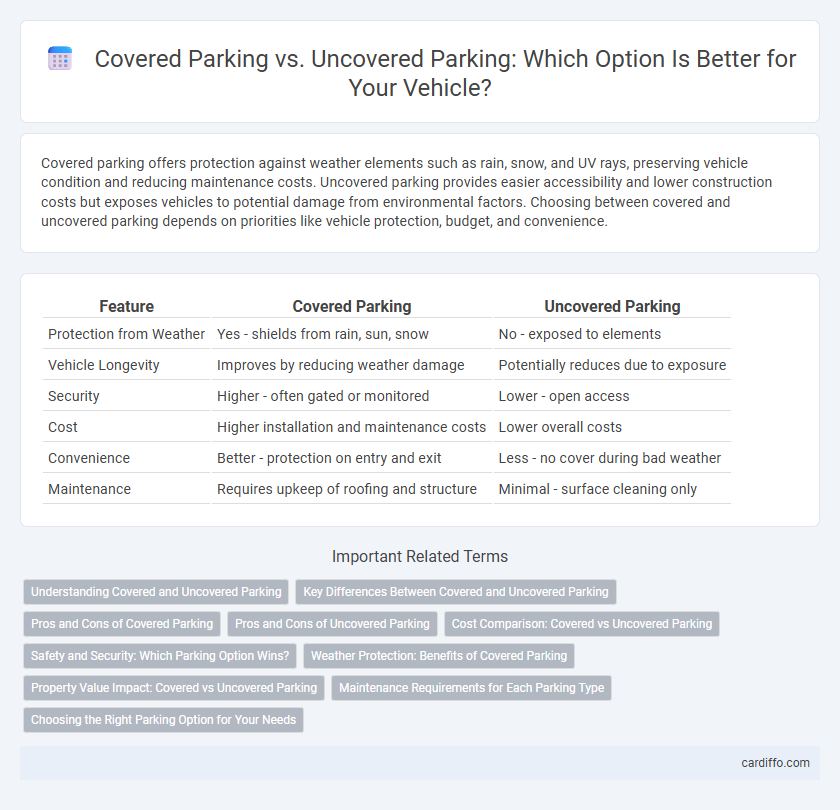Covered parking offers protection against weather elements such as rain, snow, and UV rays, preserving vehicle condition and reducing maintenance costs. Uncovered parking provides easier accessibility and lower construction costs but exposes vehicles to potential damage from environmental factors. Choosing between covered and uncovered parking depends on priorities like vehicle protection, budget, and convenience.
Table of Comparison
| Feature | Covered Parking | Uncovered Parking |
|---|---|---|
| Protection from Weather | Yes - shields from rain, sun, snow | No - exposed to elements |
| Vehicle Longevity | Improves by reducing weather damage | Potentially reduces due to exposure |
| Security | Higher - often gated or monitored | Lower - open access |
| Cost | Higher installation and maintenance costs | Lower overall costs |
| Convenience | Better - protection on entry and exit | Less - no cover during bad weather |
| Maintenance | Requires upkeep of roofing and structure | Minimal - surface cleaning only |
Understanding Covered and Uncovered Parking
Covered parking offers protection from weather elements such as rain, snow, and sun, preserving vehicle condition and enhancing security. Uncovered parking, while generally more affordable and accessible, exposes vehicles to environmental damage and potential theft risks. Choosing between covered and uncovered parking depends on factors like budget, climate, and vehicle value, with covered parking favored in harsh weather regions.
Key Differences Between Covered and Uncovered Parking
Covered parking provides protection against weather elements such as rain, snow, and sun, significantly reducing vehicle damage and maintenance costs. Uncovered parking offers lower initial construction and maintenance expenses but exposes vehicles to potential risks like fading paint and debris accumulation. Choosing between covered and uncovered parking involves balancing long-term vehicle preservation against upfront budget considerations.
Pros and Cons of Covered Parking
Covered parking offers protection from weather elements such as rain, snow, and harmful UV rays, significantly reducing vehicle wear and fading. It also enhances security by providing a sheltered space that can deter theft and vandalism. However, covered parking typically involves higher construction and maintenance costs, and can limit ventilation, potentially leading to moisture buildup.
Pros and Cons of Uncovered Parking
Uncovered parking offers the advantage of lower cost and easier access compared to covered options, making it ideal for short-term or budget-conscious users. However, vehicles parked outdoors are exposed to weather elements such as rain, snow, and sun damage, which can accelerate wear and reduce resale value. Lack of shelter also increases the risk of dirt accumulation and potential vandalism, posing challenges for long-term vehicle maintenance.
Cost Comparison: Covered vs Uncovered Parking
Covered parking generally incurs higher initial construction and maintenance costs due to materials, roofing, and structural support, which increase the overall investment. Uncovered parking requires less expenditure upfront and lower maintenance expenses but may lead to higher long-term costs from vehicle damage caused by exposure to weather elements. Cost efficiency depends on factors such as location, climate, and long-term vehicle protection needs, with covered parking providing better asset preservation despite higher costs.
Safety and Security: Which Parking Option Wins?
Covered parking offers superior protection against theft, vandalism, and weather-related damage, significantly enhancing vehicle safety and security compared to uncovered parking. Surveillance systems and restricted access often accompany covered parking facilities, further deterring criminal activity and unauthorized entry. In contrast, uncovered parking leaves vehicles exposed to potential risks, making covered parking the optimal choice for security-conscious drivers.
Weather Protection: Benefits of Covered Parking
Covered parking offers superior protection against weather elements such as rain, snow, hail, and intense sunlight, significantly reducing the risk of vehicle damage. It helps maintain the vehicle's exterior paint and interior condition by minimizing exposure to UV rays and preventing moisture buildup. This weather shielding extends the lifespan of cars while enhancing driver convenience during adverse weather conditions.
Property Value Impact: Covered vs Uncovered Parking
Covered parking significantly enhances property value by protecting vehicles from weather damage, reducing maintenance costs, and boosting curb appeal, which attracts potential buyers. Uncovered parking offers lower initial costs but may decrease overall property desirability due to exposure to elements and increased vehicle wear. Properties with covered parking often command higher resale prices and faster sales in competitive real estate markets.
Maintenance Requirements for Each Parking Type
Covered parking requires regular inspection and upkeep of roofing materials to prevent leaks and structural damage, alongside routine cleaning to avoid dirt and debris buildup. Uncovered parking demands more frequent surface maintenance such as sealing cracks, repainting lines, and managing drainage to combat weather-related wear and erosion. Both types benefit from proactive maintenance to extend durability, but covered parking typically incurs higher costs due to structural components.
Choosing the Right Parking Option for Your Needs
Covered parking provides enhanced protection against weather elements like rain, snow, and UV rays, making it ideal for preserving vehicle condition over time. Uncovered parking offers greater accessibility and typically lower costs, suitable for short-term or frequent access needs. Assess factors such as climate, vehicle type, budget, and frequency of use to select the most practical and cost-effective parking solution.
Covered Parking vs Uncovered Parking Infographic

 cardiffo.com
cardiffo.com